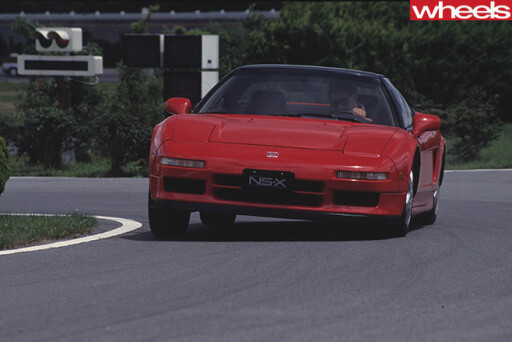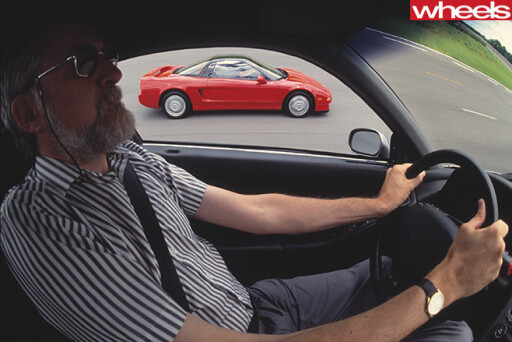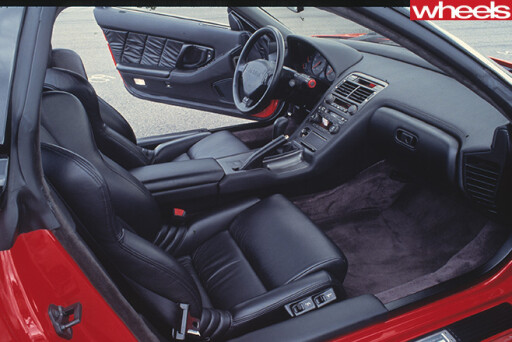
With the new Honda NSX hitting Aussie roads in November, the time is ripe to remember our exclusive drive of the original.
First published in the September 1989 issue of Wheels magazine, Australia’s most experienced and most trusted car magazine since 1953.
Phil Scott was the only Australian journalist invited to test the prototype of its 1990 Honda NS-X exotic. He reports the Japanese are well on their way to making the world’s first truly sensible supercar.
IT SWOOPS off the banking and flashes down the long straight, breaking the radar beam at 242 km/h. Sun glints off the glass canopy as it rushes towards us, cleaving the thick, still air of a midsummer afternoon.
At once it is here and gone. Now just a winking red mirage a kilometre away, trailing a rich, bellowing wake, it is a sound to ignite the emotions; a cammy crescendo that rips and soars, triggering images of northern Italy, of racing engines and supercars.
 Mr Shimojima breaks into a huge snaggle-toothed grin and lights another Mild Seven. "The sound," says Honda's white-overalled Research & Development chief, "the sound is v-e-r-y important. If we are to list the three most important items in developing NS-X, it would be one of them ... "
Mr Shimojima breaks into a huge snaggle-toothed grin and lights another Mild Seven. "The sound," says Honda's white-overalled Research & Development chief, "the sound is v-e-r-y important. If we are to list the three most important items in developing NS-X, it would be one of them ... "
This is neither Fiorano nor Sant'Agata.
And they don't wear baseball caps in Weissach. lt is Tochigi prefecture north of Tokyo, home to Honda R&D and birthplace of Japan's first supercar, an all-aluminium dart called NS-X.
Since it broke cover at last February's Chicago Auto Show it's been pooh-poohed by vested interests in Europe and America. NS-X, they sniff, with that styling it must surely stand for No Sex?
How many people will want a sanitised supercar; a copy of the real thing? They haven't driven it. They don't understand.
As one of the few international magazines invited to test the NS-X prototypes - indeed the only representative from this part of the world - we're prepared to predict that Honda will sell every one of the 6000 NS-X models it produces each year. The NS-X is not a Ferrari clone, nor is it a Porsche copy. It is something different, something unique.
 lt is a Honda mid-engined two-seater with a personality and a selling proposition that extends beyond normal supercar boundaries.
lt is a Honda mid-engined two-seater with a personality and a selling proposition that extends beyond normal supercar boundaries.
In Australia, the seemingly ambitious 200-car annual allocation begins in 1991. Expect to pay a little less than a basic Porsche 911. Expect a much broader cross-section of buyers.
The NS-X is already a sensational package, totally different in character - and in some important ways superior- to Ferrari's 328 GTB or Porsche's 911.
Heresy? No way. The NS-X is less demanding to drive, far more comfortable, and in its final form, probably faster than either of its European rivals. It is brilliantly stable at high speed, light and easy to operate, even at nine-tenths, yet practical enough to use for a trip to the supermarket. User-friendly is the term that springs to mind - and that will be the key to its success. ·
The NS-X does have flaws, although the blemishes are minor, and Honda is aware of them. But more importantly, it is unique - the world's first sensible supercar at a sensible price. With a further 12 months development before production begins, it will get better too.
"The level we have achieved is 65 per cent," says Mr Shimojima, "we have more room to improve."
The words of Honda's new President of Research & Development, successor to the charismatic Nobuhiko Kawamoto, should chill the hearts of the established European order.
That the NS-X demands to be taken seriously should go without saying.
 Honda's track record in Formula One, where it has humiliated Porsche, Ferrari, Ford and now Lamborghini, is surely a sufficient credential. Yet somehow European snootiness and disbelief persists - as does an outmoded, and yes, optimistic, viewpoint that wants to forever pigeonhole the Japanese as a nation of slavish copiers.
Honda's track record in Formula One, where it has humiliated Porsche, Ferrari, Ford and now Lamborghini, is surely a sufficient credential. Yet somehow European snootiness and disbelief persists - as does an outmoded, and yes, optimistic, viewpoint that wants to forever pigeonhole the Japanese as a nation of slavish copiers.
Initially the NS-X suffers that accusation, but with familiarity you begin to appreciate how superficial early impressions can be. Yes, styling of the early prototypes certainly bears resemblance to Ferrari. Yet the NS-X looks much better in the metal than it does in a photograph. Better still when it moves.
NS-X looks the supercar part, but has a practical 240 litre boot behind the engine compartment of that aurally delightful V6.
Honda emphatically denies European stories of a covert Pininfarina styling involvement. Their own man, 40-year-old chief designer Masahito Nakano, of Prelude fame, is credited with the NS-X.
His brief, and this could only happen in Japan, was to build a supercar that "resembles a muscular-bodied jet-fighter making a low pass".
Yet all is not as it seems, for what you see today won't be what flows off the line at a new plant next door to the R&D Centre in Tochigi, this time next year.
"The prototypes you see will be different...from the final design," says Mr ShimOJima, with a mischievous smile.
"We will give it more distinct character, some partial changes to styling..."
Exactly what changes? Now he chuckles: "Some C pillar modifications and about four other items. You will see them next year."
NS-X prototypes 0000002 and 000003, are at our disposal to drive around the Tochigi Proving Ground's high-speed bowl and inside it - on the light handling course. These May build cars are already outmoded, cautions Shimojima, by prototypes built in August. The chassis numbers have now reached 0000015 and still the changes come. Our two cars, a red manual and a red automatic are made ready.
 In the metal - and remember it is aluminium from stem to stern, including the double wishbone suspension – the NS-X is much longer and lower than the motor show pictures depict. The longer you spend with the car the more the Ferrari image fades.
In the metal - and remember it is aluminium from stem to stern, including the double wishbone suspension – the NS-X is much longer and lower than the motor show pictures depict. The longer you spend with the car the more the Ferrari image fades.
The rear overhang on the NS-X is exaggerated, deliberately so to improve yaw response, and the ground-sniffing snout more elongated than the telescoped, front three-quarter press pictures, issued by Honda's PR machine.
The canopy, modelled as it is on an F-16 fighter, is placed well forward. As previously explained, the dogfighter link is no piece of Japanese embroidery.
Unlike two-seaters from Maranello and Hethel, the NS-X is easy to enter, despite its close proximity to terra firma. No bumped heads, no barked shins. Once inside the cockpit - and it does convey a heavy Porsche 928 wrap-around feel - you're aware that something is amiss.
You're comfortable. As comfortable as in any BMW saloon, although your hip point is much lower and the seats are heavily padded rather than Teutonically firm. The steering column adjusts for tilt and reach, the big aluminium-framed electric seat whirrs into place. The pedals and stubby gearshift are natural extensions of the feet and fingers…and the visibility is simply astounding. There's none of the upright, skew-whiff articulated ergonomics of the 911, none of the discomfort tolerated in a 328, and unlike the Countach or Esprit, your view of the world is panoramic.
Switch on the ignition and the 3.0 litre 24 valve V6 pulses to life. No reticence, no prima donna temper, it fires as readily as a Civic but emits a deep, resonant beat from behind the shoulders. Engage the clutch. It's as light as a Prelude.
Out onto the high-speed bowl, squeezing the throttle and working up through the five-speed gearbox, the engine sounds like a very smooth V8. The shift is beautifully weighted and slick.
Grandma could shuffle down through this transmission as easily as Alain Prost dropping five ratios under brakes at the end of Dequetteville. It's that precise, that easy. And the bark from the NS-X exhaust means the old girl's heel-and-toe polka would sound almost as good as Alain's in the MP4.
 Chassis engineer Taki has advised that speed must be kept under 220 km/h around the banking. More than two lateral Gs, he warns, is not advisable, but the straights are unrestricted.
Chassis engineer Taki has advised that speed must be kept under 220 km/h around the banking. More than two lateral Gs, he warns, is not advisable, but the straights are unrestricted.
This single cam stage one engine produces 184kW (250 hp). The production V6 will be equipped with twin cam heads and Honda's variable valve timing (VTEC) system which will lift output to nearly 200kW, extend the redline from 7200rpm to 7700rpm and shave two tenths off the standing quarter. This single cam prototype is good for 13.7 or 13.8 seconds, say the Honda men. The VTEC version should give 13.6 a shake.
Both are brand new engines, produced by a team including ex-Formula Two designer Kidamato. As such, they are not developments of the Legend's 2.7 V6.
Torque delivery, even from this 'cooking' model, is delightfully even. It will pull away from as little as 1800rpm in fifth gear, gathering strength until it hits 4000 revs. From there to the redline it fairly snarls, emphasising that the men who designed it are no strangers to the racetrack. lt has both tractability and top-end lungpower. The VTEC version, with its stronger upper range, is a mouthwatering prospect. Honda says the twin cam V6 is the world's most powerful naturally aspirated production engine - both in terms of torque per litre and power per litre. They're not quite right.
Although the NS-X narrowly wins the power race, BMW's M5 has a superior torque ratio. lt doesn't matter, for even the single cam V6 has enough spark to amaze and delight. With VTEC, no owner will complain of being underpowered.
High-speed bowls are deceptive places to evaluate any car. There's no reference point, particularly in a car like the NS-X. Even at 240 km/h it tracks so true, sits so flat and stable, that it's only when you mash the brake pedal that speed and distance relativity are brought to sharp focus. lt takes a long time to stop from 240 km/h, even with Honda's new four-channel ABS brakes.
By comparison, the wingless Porsche 911 so thoughtfully provided by Honda, shuffled nervously, the steering wheel kicking and bucking in typical Weissach style. The Ferrari 328, also part of the Honda garage, was unfortunately hors de combat, the clutch fried during an earlier visitation by the Japanese press.
Our British colleagues, however, confirm the NS-X has superior high-speed stability than even the 328. Let us not forget that Ferrari has a new 348 ready for release, and that the 911 is effectively dead, to be replaced by the Carrera 2 this spring. In that sense it is as well that Honda aimed higher than these two vintage designs.
Back in the briefing area, there are two questions I need answered . Why no four wheel steering or four wheel drive?
"Because both would have added weight," says Uehara, the project leader.
"To use 4WS means another 50 kilograms, four wheel drive an extra 100kg. As well, it would mean a new dimension for the central tunnel and enlarge the size of the car."
Weight saving is a dominant theme with these engineers. Their first prototype was made of steel but discarded because it was too heavy. The aluminium body alone shaved 140kg. Using aluminium suspension components, engineered as finely as any open-wheel race car, brings the total weight saving to 200kg. All up, the NS-X tips the scales at 1280 kg, with the weight balanced 43/57 over the front and rear axles.
There were problems getting the aluminium monocoque as torsionally stiff as steel. It's one area Honda is still developing, following Ayrton Senna’s testing of the car at Suzuka. The Brazilian wants more bodyshell stiffness and by production time, we'll have it.
Senna, of course has spent plenty of time on Honda's Tochigi handling circuit. Maybe that's why the NS-X chassis feels so good. In general terms it's difficult to fault. So easy to drive, so responsive you can hang it out and balance it on the throttle. Given the tight nature of the course, any tendency to understeer is highlighted. The NS-X pleads guilty, but the front-end pushing of the Yokohamas wouldn't be considered excessive in the real world. The silver automatic is a different story. Honda claims "no real differences" in suspension tune, but concedes there are some. The other major difference is the steering. The red car uses manual steering that's well weighted and loads up progressively, conveying plenty of feedback and, in my opinion, obviating the need for any assistance.
The automatic, however, uses new electric power steering that’s simply too light and dead. Honda concedes it’s still developing complicated software for the system, but ultimately it will replace conventional power steering, which is why it’s being developed for the NS-X, where weight and space are priorities.
The combination of auto transmission compromising comfort or convenience. and electric steering produce quite a different character. Indeed Editor At Large Robinson's first comment as he steps out of the auto into the manual is quite right. "These are different cars," he exclaims. Indeed.
Two laps later a combination of high lateral G forces and exuberant driving sees the red NS-X scream to a halt. Our man from Italy decides to part company with his breakfast, evidence that there is nothing wrong with the grip level generated by the NX-S.
The suspension is softer than a ballsout supercar should be, more supple and more prone to body roll. Yet it looks a lot worse from the outside than it feels from behind the wheel.
Ride quality? We simply don't know. Not after such a short stint in an environment as far removed from the real world as Monaco or lndianapolis.
What we do know is that Honda is bang on target. The NS-X, whatever they decide to call it, richly rewards those 98 out of 100 drivers who don't possess the skill and bravery to wring the last ounce from a 911 or a 348. lt has supercar performance and super levels of comfort and practicality.
Whoever heard of a Testarossa-beater with a 240 litre luggage compartment and which doesn't leave Agip stains on the driveway?
Reliability and dependable service are very much part of the NS-X strategy.
As it stands, Honda's new supercar is really no threat to Ferrari. Not because it doesn't richly deserve comparison, but because you don't buy a Seiko LaSalle if you can afford a Rolex.
But Porsche, particularly with models like the 944, and Lotus, with the Esprit, should worry like hell. The NS-X produces high stimulation, high excitement, high driver satisfaction... without compromising comfort or convenience.
That's not to suggest the NS-X is anything other than a driver's car. Honda has lapped the NS-X around the old Nurburgring in a consistent 8 minutes 30 seconds. Jimmy Clark wasn't much faster when he took the Formula One pole in 1967. Today, cars like the 928 Porsche are struggling to crack nine minutes. The essence of Honda’s new entry is that everyone can be Ayrton Senna.
HONDA NS·X
GENERAL
Transverse mid engine, rear wheel drive
List price: around $125,000
ENGINE
Bore x stroke: 90mm x 78mm
Displacement: 2977 cm3
Fuel system: electronic fuel injection
Power: 184-199 kW @ 6800-7300 rpm
Torque: 285-288 Nm@ 5300-6500 rpm
(Prototype engine has sohc per bank and four valves per cylinder. Production version 1990 will have dohc, variable valve timing)
TRANSMISSION
Five-speed manual
MEASUREMENTS
Wheelbase: 2500mm
Length: 4315mm
Width: 1800mm
Height: 1170mm
Kern weight: 1280 kg
SUSPENSION
Front: Independent, double wishbones, coil springs
Rear: Independent, double wishbones, coil springs
STEERING
Rack and pinion
BRAKES
Anti-lock ventilated discs/ventilated discs
WHEELS & TYRES
Cast aluminium alloy, 15-inch front, 16-inch rear 205/50ZR15 front, 225/50ZR16 rear
PERFORMANCE
0-100km/h: (Manufacturer's claims) 6.0s
Top speed: 255-270 km/h

COMMENTS